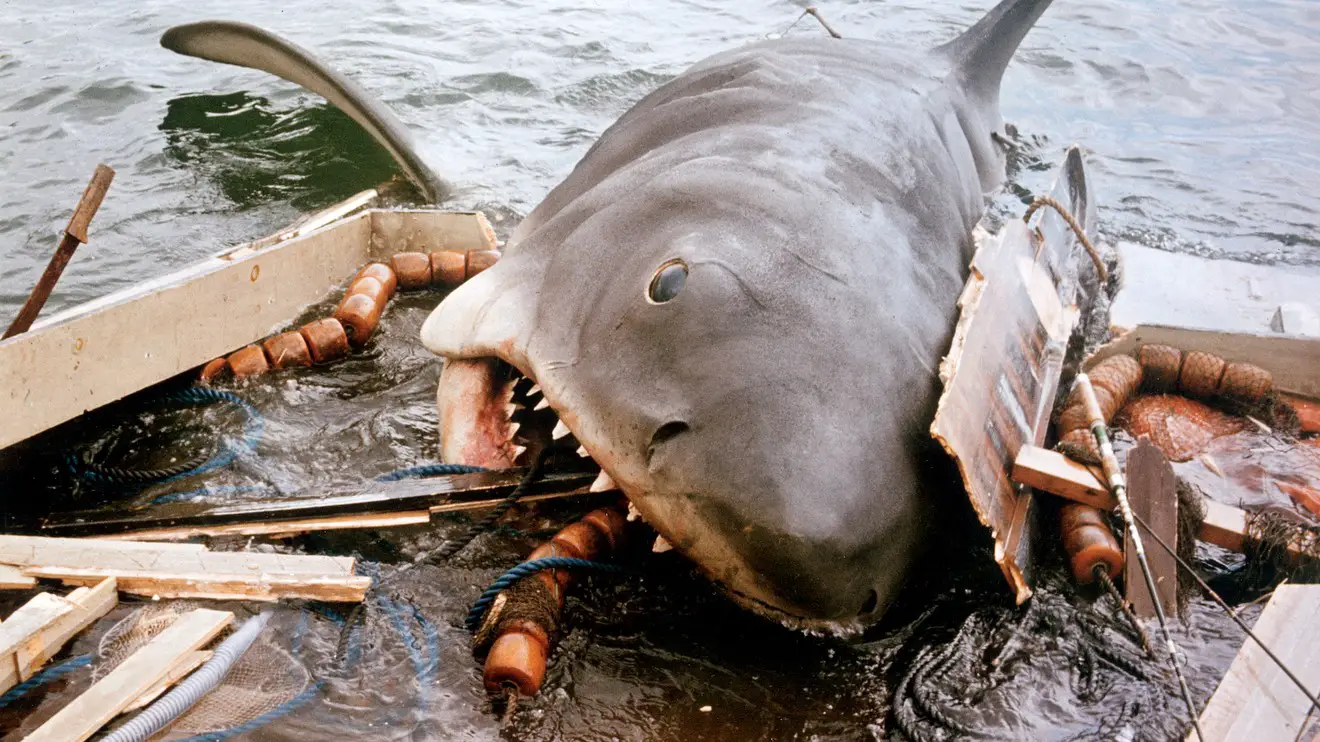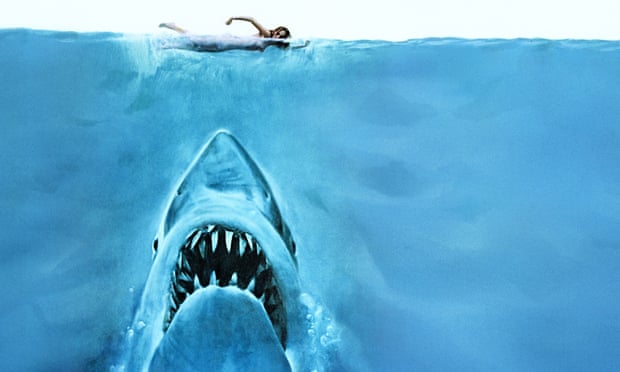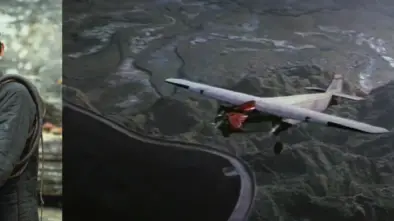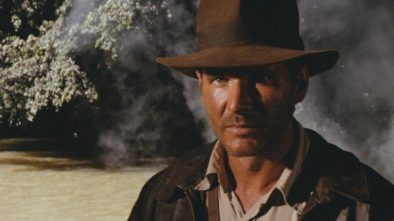‘Jaws’: The Monster Movie That Invented The Summer Blockbuster

How did a B-movie-type monster movie become a genre-defining blockbuster that changed modern film-making?
On June 20, 1975, Jaws opened across North America and changed the film business forever. Opening a film in the middle of summer was considered box office suicide before Jaws. The time was for swimming and sunbathing at the beach, not sitting in a darkened movie theater. However, Steven Spielberg’s story about a monster shark terrorizing the small island community of Amity soon changed that. Thousands were scared out of the water into multiplexes to watch Bruce, the mechanical shark, chew up hapless swimmers.
A new formula drew thousands of filmgoers into theaters that included the proliferation of multiplexes in shopping malls, a reliance on massive marketing drives to attract audiences, and the establishment of the ‘event’ film. Quite simply, Jaws redefined how blockbuster entertainment was made, distributed, and marketed. The film is seen as the template of contemporary blockbuster releases that redefined what a “hit” is artistically, demographically, and financially. With Jaws, the Summer Blockbuster was born, and this same formula produced even bigger blockbusters like Star Wars: A New Hope and Spielberg’s, E.T. the Extra-Terrestrial, in proceeding years.
Monster summer splash
There had been blockbusters before. Epics like Gone With The Wind, Lawrence of Arabia, and the James Bond film, Thunderball were box office phenomenons in their time. All were typically released during the Christmas holidays, which was seen as the time when the best box office results could be achieved. What was different with Jaws was not only the Summer release date but also the time it took for movies to rake in their impressive box office hauls. Films like Gone With the Wind and Thunderball were year-long events that steadily and consistently accumulated their box office totals. Jaws, on the other hand, ushered in the front-loaded blockbuster, fueled by a massive advertising campaign.
The massive advertising budget for Jaws signaled the beginning of the all-important opening weekend.
Thousands of moviegoers were attracted in the first weekend and the following few weeks of its release. As weeks turned into months, audiences and the box office tapered off. However, by then the hype had done its job with the majority of the money made quickly. In its first 35 days of release, Jaws sold 25 million tickets earning an impressive box office of $102.5 million. In little over a month, the film had become the first film to break $100 million at the U.S. box office, smashing records set previously by The Godfather and The Exorcist. Adjusted for inflation, its worldwide box office total of $470 million (off a $7 million budget) is estimated to be near $2 billion today.
Jaws had quickly become the highest-grossing film of all time thanks to its front-loaded marketing machine. Two years later, Star Wars: A New Hope would follow the same formula and take the box office crown. $100+ million hits were now the norm and would be produced faster than ever.
From Bookstore to Television to a Wide Cinema Release
The monster-sized marketing campaign for Jaws was unprecedented. Peter Benchley’s paperback novel of the same name generated the initial buzz when it hit bookstores in 1974 and quickly rose to No. 1 nationwide. The film’s producers Richard Zanuck and David Brown had preempted the book’s success by quickly snapping up the rights for $150,000 before the book was published.
Universal then fast-tracked Jaws into production, with a 26-year-old Spielberg at the helm. Spielberg was a gamble and soon proved to be a solid choice as director, displaying confidence and ability uncommon in young filmmakers at the beginning of their careers (Spielberg, who had just come off directing Duel, only got the gig after the first directorial choice, Dick Richards, kept referring to the shark as a “whale”).

Steven Spielberg, Roy Scheider, and Robert Shaw on set of “Jaws” in 1975. EVERETT COLLECTION INC.
While in production, the book sold 5.5 million copies. Capitalizing on this buzz, Universal spent $700,000 on trailers that flooded prime-time television weeks ahead of the film’s release (In all, the studio would commit $1.8 million to marketing). This marketing strategy was first tested on The Godfather, but with Jaws, Universal spent considerably more. The sight of crowds lined up around the block waiting to get into theaters on the film’s release proved the marketing blitz worked. And the fact that many film-goers quickly went back for a repeat viewing proved that Spielberg was box office gold.
The film’s marketing blitz was matched by its wide distribution. This is a key element in front loading a film, with the goal of earning maximum box office in the shortest possible time. And Jaws capitalized on a phenomenon that had risen since the mid-Sixties. From 1960 to 1970, shopping malls in America had grown from 1,500 to 12,500, and many contained cinema multiplexes. The mall was the natural stomping ground for teenagers not keen on the beach, and this group became the target demographic for Summer blockbusters after Jaws. It helped that malls were air-conditioned, becoming a cool alternative to the sweltering heat of North American summers.
On opening night, Jaws was released on 464 screens. Never had a film been released on such a large and far-reaching scale. Today, thanks to Jaws, the strategy is commonplace, with a potential blockbuster typically launched in 2,000 to 3,000 theaters.
Accompanying the film’s release, were merchandise and promotional tie-ins, including Jaws-themed ice-creams. Two years later, George Lucas would turn merchandise into a billion-dollar income stream, which rivaled the box office takings of his own film, Star Wars.
Finally, the impact of the film generated significant word of mouth, which just added to Jaws’ impressive box office haul. “Jaws went viral through word of mouth,” said Paul Dergarabedian, senior media analyst for box-office tracker Rentrak. “It became bigger than the sum of its parts. Everyone was talking about it.”
Following Jaws, television advertising and merchandising strategies were paramount for studios. The summer movie season now accounts for 40% of the studios’ annual revenue. Nearly half of a studio’s total production budget will go on publicity and marketing.
The ‘Event’ Film
Universal and Spielberg effectively turned a B-movie into box office gold. With high production values, great direction, good actors, a solid, human story surrounding the shark attacks in the small community of Amity, a memorable music score, and the best special effects available at the time, Jaws ushered in the ‘event’ film.
The ‘event’ film, which is now synonymous with the Summer blockbuster, typically features a high concept idea, typically defined as some big threat or spectacle which attracts audiences in droves. According to Carl Gottlieb, who co-wrote Jaws with Peter Benchley: “That notion of selling a picture as an event, as a phenomenon, as a destination, was born with that release.”
Jaws, which relied on a mechanical shark rather than a big-name star to draw in audiences, also started to shift the interest of audiences from the star headlining the picture to the person behind the camera who made the film. Jaws is arguably the first film to introduce the idea of a big-name director, whose name could attract thousands to theaters just like a big-name star. Spielberg was the first, dominating the late Seventies, Eighties, and even the Nineties, with high-concept ideas like Raiders of the Lost Ark (and its sequels), E.T. the Extra-Terrestrial, and Jurassic Park. Soon, he would be followed by new directors like James Cameron, and Michael Bay, and super-producers like George Lucas and Jerry Bruckheimer. With these names attached, audiences knew exactly what kind of film they were going to get, and these names almost always guaranteed big box office for studios.
One of the key ingredients of an event film is its impact. “Almost everyone remembers when they first saw Jaws,” said the film’s producer David Brown. “They say, I remember the theater I was in, I remember what I did when I went home – I wouldn’t even draw the bathwater.” Films like Jaws leave a mark on memory similar in effect to seismic historic events like the assassination of John F Kennedy, and, later, 9/11. Films like Star Wars: A New Hope and Jurassic Park had the same effect for many. Since Jaws and the onset of the Summer Blockbuster, every generation has its movie that leaves that indelible mark.
Spielberg’s monster shark movie really was the beginning of Hollywood’s summer movie machine. More movies were made and served up to satiate the growing demands of audiences. There were imitators (Alligator, Orca, Anaconda, and Alien, which was pitched as Jaws in space), and originals. But they all had that same larger-than-life premise. Every year they got bigger. Bigger budgets, and bigger in scope. But all of them from Star Wars, E.T. the Extra-Terrestrial, and Indiana Jones in the 70s and 80s to the current cinematic universe craze owe a debt to Jaws, the original Summer blockbuster.




